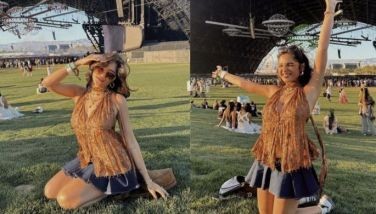How Sean Ellis fell in love with Metro Manila

For a British director to shoot an original English screenplay entirely in Filipino, with Filipino actors cast in the principal characters, he must have fallen deeply in love with the Philippines.
That, in nutshell, is the story of Sean Ellis whose film Metro Manila was submitted by UK as entry in the Best Foreign Language Film category of next year’s Oscars. Included in the official selection of the 2013 Sundance Film Festival, Metro Manila, directed and co-written (with Frank E. Flowers) by Ellis (from his own original idea), is the story of Oscar Ramirez and his family who decide to move from the poverty-stricken rice fields of Northern Philippine mountain ranges to Metro Manila in search of the proverbial greener pasture, only to be victimized by the manipulative ways of the city folk. Oscar (played by stage actor Jake Macapagal, also an associate producer of the movie) manages to land a job as a driver for an armored truck company and is befriended by Ong, his senior officer. It turns out that Ong has been planning the arrival of someone like Oscar for some sinister scheme. Also cast (as the villain) is John Arcilla, along with other Filipino actors like JM Rodriguez and Althea Vega.
Ellis started taking pictures at 11 and later trained as a still-life photographer. In 1994, he moved from Brighton to London where he became a most-sought-after fashion photographer. He has written and directed short films, including Left Turn (2001), a dark psychological horror film and Cashback (2004) which won top prizes at more than 15 international film festivals (Tribeca, Chicago, etc.) and nominated for a 2006 Oscar Award. His 2008 film, Voyage D’Affaires, was shown at the Hamptons Film Festival and the Chicago Film Festival, and was nominated for a 2008 British Academy of Film and Television (BAFTA) award, and won Best Film at the 2010 Fuji Short Film competition.
Here’s Celine Lopez, an executive producer of Metro Manila, on Ellis:
“Sean and I have known each other since 2006 when he visited Manila. Since then we started talking about doing a film here. Sean was very inspired and fascinated by the bustling city of Manila. Then around 2010, he and I just said, ‘Screw it; let’s do this.’
“We set up castings in restaurants and later on we had a small office in RCBC. The whole AD Hoc nature of the way the movie was done added so much soul to it. Also we were lucky to have all these generous people lending us a hand...gratis. Timmy Tan of Philippine Airlines (then) actually lent us a 747 for the day. That was used to do one of the most powerful scenes in the movie, a side story of a character’s desperation played by JM Rodriguez.
“Sean would tease me about the magic powers of my Blackberry. However, truth be told, even I was surprised by the generosity of everyone who supported the movie. The actors most especially gave their all for this passion project. It was an inspiring time. An absolute adventure. Something like this, a little film that became a Sundance darling without any PR or gimmicks, off to becoming the UK Official Selection for the Oscars is a reminder that things do happen for a reason. If you love what you’re doing, as was the passion of everyone who was involved in the movie, the world will love it, too.
“I remember during Sundance I kept playing the Ellie Goulding song Anything Could Happen over and over again. Anything can really happen.â€
Conversations did an e-mail interview with Sean Ellis last week.
First congratulations on having your film, Metro Manila, chosen as UK’s entry in the Best Foreign Language Film category of next year’s Oscars. Your short film, Cashback, was also nominated for an Oscar, Best Short Film category Live Action, in 2006. How does this “second time around†feel?
“It’s an incredible honor to be recognized by the The British Academy of Film and Television Arts (BAFTA) which is the organization appointed by AMPAS to select the UK’s submission for consideration for the Foreign Language Film Award.â€
Tell me about the background of the film, how and why you chose that subject for your movie.
“Everything started with a fight. I saw two employees of an armored truck company in full combat mode — that is, M16 guns, bulletproof jackets and Kevlar helmets — screaming at each other in front of their armored truck. The fight ended with one of them kicking the truck before they both got in and drove off. All this was enough to stimulate my imagination.â€
That was during your visit to Manila, right?
 A scene from Metro Manila with Jake Macapagal and Althea Vega with child actress. Above: Ellis with his loyal friend.
A scene from Metro Manila with Jake Macapagal and Althea Vega with child actress. Above: Ellis with his loyal friend. “Yes, I was visiting a friend in Manila at that time. I witnessed this quite surprising event which stayed in my mind when I went back to UK. I kept on wondering what the two men were arguing about. You see, if an idea keeps cropping up in your mind, it’s something important enough to pursue.â€
How soon after that did you start writing the story?
“The idea percolated in my mind for 18 years. Then, I wrote a 20-page synopsis with a clear beginning, middle and ending, all based on the scene that I witnessed. I flew to L.A. to meet Frank, an old friend. For two weeks, we worked on a script that fleshed out the synopsis that would be the basis of the film. It wasn’t complete but along with faith and passion, I went back to the Philippines to see if it was possible to put the project together.â€
How was it selling the project to financiers?
“The project generated much interest but the idea to shoot it in Tagalog that made the project hard to sell to financiers. I just couldn’t imagine going to the Philippines and making a film there where the actors spoke English. Great films always transcend their subtitles. I had to at least aim in the same direction, or risk the film’s authenticity.â€
(Together with Mathilde Charpentier, one of the film’s producers, Sean prepared a budget for the project with a stripped-down documentary approach, and planned a cast and crew made up of all Filipinos. The no-thrills guerilla approach enabled the producers to raise enough money for the 35-day shoot for the principal photography.)
“I made a thorough research on the Philippines during the pre-production and I adjusted the script accordingly. In the original script, the family leaves the rice fields and travels to Manila on a train. But I found out during my research that there was no train to the northern province. We had to be accurate or I would feel a fraud if the Filipino audience noticed any continuity problems.â€
Did you include in the script any other real-life incident in the Philippines?
“There was also the true story of Reginald Chua (played by JM Rodriguez) who hijacked a Philippine Airlines flight (PR812). Reginald worked for his father who owned a silk factory. A local rival killed Reginald’s father and the workers in the factory were also threatened. Reginald’s father had no choice but to close the factory. With mounting debts, Reginald boarded the plane and hijacked it at a gunpoint. After stealing the money of all the passengers, he jumped from the plane on a hand-made parachute from the silk of his father’s factory.
“The story of Reginald was so heart-breaking that I couldn’t help but use it to draw parallels with the plight that the character of Oscar finds himself in. It serves more than just a back story of a lesson in life; it weaves truth and fiction into an emotional climax for the film’s finale.â€
Didn’t you have any language-barrier problem since the script is in English and you wanted the film to be in Tagalog?
“The language barrier was never a problem. Right from the start of the shoot, I was fortunate enough to meet an incredible film team. Each and everyone of the cast and crew were devoted to give their best, not minding the long shooting days, the humid weather and how stressful a tiny-budget film could sometimes be. Even if most Filipinos speak English, Tagalog remains their everyday language. Directing in a foreign language could be a traumatic experience but I actually took advantage of the situation.
“The process of working in Tagalog became all about the rhythm of dialogue, not words. I became acutely aware of subtext — you know, what people don’t say is far more interesting than what they say. My actors and I would talk at great lengths about the script’s dialogue, its meaning and its intention.
“The script was in English, all right, and the actors would then make their own translation into Tagalog. That way, each actor gives a voice to his or her own character. If the whole script was translated into Tagalog by one person, then that became the voice for the film and I didn’t want that.â€
How did you choose the cast?
“Jake was the first actor to be cast. It was Celine who contacted him for a breakfast meeting with her and me.â€
Recalled Celine, “I felt during our encounter that they needed help in terms of being connected to the ‘indie’ industry. So I rang up several actors I know and asked them to meet and greet Sean the very same day.â€
 The British Embassy, British Council and its partners are hosting a special advance screening of Metro Manila as part of its ‘This is GREAT Britain’ campaign, a five-month celebration of the best of British business and culture, building mutual prosperity and deeper friendship with the Philippines. Aside from Jake (above) and Althea (below), another Filipino actor in the cast is John Arcilla (left).
The British Embassy, British Council and its partners are hosting a special advance screening of Metro Manila as part of its ‘This is GREAT Britain’ campaign, a five-month celebration of the best of British business and culture, building mutual prosperity and deeper friendship with the Philippines. Aside from Jake (above) and Althea (below), another Filipino actor in the cast is John Arcilla (left). Jake (who was a cast member of the Miss Saigon German production) related his first meeting with Sean.
“I assumed that I would be helping on the production side, which I didn’t mind. I asked him for the character breakdown of Oscar and thought, ‘I know the type Sean was looking for...’ Not me. I read for him and read several possible actors during the casting and I was offered the lead several days after. I received a call from Sean and he told me that he knew I was Oscar the moment we sat down for breakfast. That was the very first day we met.â€
During that meeting, added Jake, Sean asked him, “Are you ready to take this journey with me?â€
So Jake looked into what he described as Sean’s iridescent eyes.
“I knew that I could not lose this adventure with Oscar and I plunged into the unknown. The script was brilliant and I had vivid dreams of the execution. From then on, it was everything else was supposed to happen. And then we exhaled. Oscar’s plight is not different from that of every Filipino. All I had to do was open my eyes to reality and I was in Oscar’s world. I didn’t have to look far to smell, taste and live it.â€
“Next to be cast was John. Finding the actor for the role of the antagonist took more time. I was looking for something hard to put in word and I could find some of it in some actors but I was never blown away by any one of them. When John auditioned, he was on fire. I realized that he would bring to the table something I hadn’t thought of — complexity. He’d be a bad guy that you couldn’t help but love. You almost wanted him to succeed with his plan, and John brought this trait with him.â€
Describing Sean’s work style, John (who is currently residing in the US) said, “Sean is cool. It’s like working with a teammate. I really felt that I was part of the creative process. No pressure at all. It was as if we were discovering new things along the way. He was a perfectionist, too, which worked well with me. He wouldn’t stop until he got the right image and the right angles.â€
How was the whole shooting experience?
“Filming in Metro Manila started on Dec. 14, 2010, and wrapped on Jan. 31, 2011. Shooting in the Philippines was a grueling yet extraordinary experience for a Westerner director. From the extreme poverty in the slums to the enigmatic beauty of Banaue’s rice fields, the cast and crew found nothing but smiling faces and welcoming eager to help with the filming. The Philippines really became part of the cast.â€
Some Oscar veterans (like Filipino director Gil Portes who has had three of his films entered in the Best Foreign Language Film category of the Oscars) said that the chances of an Oscar entry (semi-finalists and finalists) are improved if they (films) are shown in a film festival like Sundance and Palm Spring so the Oscar voters can better see them. Do you agree?
“Yes, I would agree with this but they are also competition festivals, so a selection process is still needed in order for the film to be chosen to play in these festivals.â€
How was your first Oscar experience and what did you learn from it?
“It is always nice to be recognized for the work you do but it’s also a by-product of the work and it shouldn’t affect the way you work. It does often help open doors to projects you might not have a chance to be working on.â€
At what point in your life did you realize that you wanted to be a filmmaker? What film was instrumental in that realization?
“Probably after I saw the film Alien. I was 12 when I finally saw Alien on home video and it scared the s@#t out of me. I came to understand the power of story, design and lighting. It was just an incredible package — I knew that was what I wanted to do.â€
Did you know that the Philippines has also submitted an entry, Transit, directed by a new director, in the same category at the Oscars, and the Singapore entry, Ilo Ilo, also has a Philippine “flavor�
“Yes, it’s amazing that three Filipino stories have found their way into the Oscar race. It’s a testament to the fact that the Philippines has great stories that can be brought to the world stage, with films from Brillante Mendoza, Raymond Red and Erik Matti already finding international audiences. It could just be the start of the golden age of cinema for the Philippines. It certainly has the eyes of the international film community looking at Filipino stories and what they have to offer.â€
What are the films that you grew up on and who are the directors that you look up to as role models?
“There are many directors whose work have shaped my own journey. Many British directors like Alfred Hitchcock, Adrian Lyne, David Lean and Ridley Scott have been a stable diet in my film growth. I’m still an audience member and still love to seek out films that capture my imagination as well as my emotions.â€
(E-mail reactions at [email protected]. You may also send your questions to [email protected]. For more updates, photos and videos visit www.philstar.com/funfare or follow me on www.twitter/therealrickylo.)
- Latest
- Trending
























 Exclusive
Exclusive




